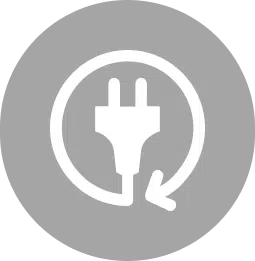Setting up energy in the UK
Here’s everything you need to know about energy in the UK, including how to find a good energy tariff, set up energy accounts, billing and submitting meter readings so you can stay on top of your bills.
Take control of your energy bills
Energy costs have skyrocketed since the 2021 energy crisis, making it more important than ever to manage your household bills effectively.
Just keeping an eye on your usage is no longer enough – making sure you’re on a good value energy tariff and understanding how you’re being billed are essential to avoid a scary end-of-year payment.
Here’s everything you need to know about energy in the UK, including how to set up energy accounts, billing and submitting meter readings so you can stay on top of your bills.
How is energy distributed in the UK?

Generation
Electricity is generated from a mix of renewable production, fossil fuels and nuclear power.

Wholesale purchase
Electricity suppliers purchase electricity and gas at wholesale prices determined by demand and supply.

Supply
These energy suppliers provide energy to the National grid, and set up contracts with consumers to buy gas and electricity.

Distribution
Your local energy distributor is responsible for delivering the gas and electricity to your home.
Setting up energy bills when you move
Energy bills in the UK are based on consumption, and you don’t want to end up paying for someone else’s usage. That’s why it’s important to let the current energy supplier know you’re moving, even if you want to switch suppliers in future.
Let the current supplier at your new home know your move in dates, opening meter readings and your contact details so you can open an account from the date you become responsible for the property. If you’re not sure who the current supplier is, or if you want to save time, our free utility set up service can handle everything in one short call, alongside all your other utilities.
Take meter readings when moving home
Take meter readings on your moving day in both your old and new home. Send the old readings to your previous supplier so they can close your account and don’t overcharge you for energy.
Notify current supplier
There will be a supplier in place at your new property so you’ll have power from day one. You should notify them when you move in, so you will be charged the correct amount for energy.
Look for better tariffs
Switching suppliers can help you save on energy bills, and the process can take up to four weeks. But don’t worry, you won’t lose power at any point.
What to do during power cuts
Power cuts are uncommon in the UK, but outages do happen sometimes. If the electricity at your home does go out, here’s what to do.
Kinds of energy tariffs in the UK

Standard variable tariff
A standard variable energy tariff is the default tariff in the UK. It’s the tariff you’ll be placed on when you move until you choose to switch. The amount you pay per unit is controlled by the energy price cap and adjusted every 3 months based on wholesale energy costs.
💡 Why choose a variable tariff?
Variable tariffs track wholesale energy prices, so your bills can fall. However, energy costs have been steadily increasing over the last decade.
Some reasons why you should choose a variable tariff:
- There is no minimum contract length, so you can switch any time
- Energy costs can go down, saving you money on bills
- Always available, even when wholesale prices are high

Fixed tariff
A fixed tariff is one where the amount you pay for each unit of gas and electricity doesn’t change during the contract. Your bill is still based on your usage, but a jump in energy market prices won’t affect your bills until the end of your contract term.
💡 Why choose a fixed tariff?
Fixed tariffs offer a greater level of control over your bills as you can rely on your rates staying the same for the duration of your contract. Fixed tariffs are also often cheaper than standard variable tariffs for the same usage levels.
Some reasons why you should choose a fixed tariff:
- Prices remain fixed throughout the contract term
- Competitive pricing means you can save on your bills
- In events like the UK energy crisis, your bills will stay the same
How do I switch energy tariff?
Switching energy tariff is a simple process that only takes a few minutes. Once you’ve chosen the tariff you’d like to switch to, you just need to provide a few details about yourself and your home including a current meter reading.
Looking for a quote for a great value fixed rate tariff? Book a free call with our team and they’ll be happy to take you through your options.
Will I have energy supply while switching suppliers?
Yes. When you switch energy suppliers or tariff, your energy will still be managed by the same distributer. Your supplier must continue to supply your energy until you switch to a different contract with them, or a new contract with a different supplier. That means there’s no installation needed at your property and there will be no interruption to your supply.
Choose a tariff
Choose the tariff and supplier you like, whether it’s the best value, the greenest option or any other priority.
Register to your new supplier
To switch energy tariff, you simply have to register to your new provider- they’ll handle closing your old energy account for you.
Get your opening bills
Your first bill on your new tariff and your closing bill from your old supplier will arrive by post in 4-6 weeks.
How is my energy bill calculated?
Your energy bill is consisted of a few different costs: unit rates, standing charges and taxes (e.g. VAT). These are used together to calculate your bill.
What are unit rates?
Your tariff includes a unit rate for electricity and gas (if you use it). This is the price you will pay for each kWh (Kilowatt-hour) of energy you use, referred to as a unit. Your energy consumption is measured by your meter.
What is a standing charge?
The standing charge is a fixed daily charge you pay for access to the UK energy network, called the National Grid. This is a cost set and charged by your supplier. All properties must pay the daily standing charge while they remain connected, even if no energy is used. The standing charges are reviewed by Ofgem every three months along with unit rates when the Energy Price Cap is updated.
How to read your energy bill
With lots of specific terminologies, energy bills can be confusing for those who are unfamiliar. We’ve published a complete guide to understanding your bill.
How to test your energy meter
If your meter is faulty, you can be charged for energy that you didn’t use. Making sure your meters are as accurate as possible means you can avoid overpaying. Learn how to test your meter here.
4 types of meters in the UK
Your energy meter measures your consumption of gas and electricity. This is how your supplier knows how much to bill you, so being able to read your meter correctly is key.
There are a few different kinds of meters installed in homes across the UK. The type of meter you have can affect how and how much you pay for your energy. You can contact your current supplier about having a different meter installed if you’s like to switch.
The 4 types of meters you will find in the UK are:
- Standard credit meter
- Economy 7 meter
- Prepayment meter
- Smart meter
How to take meter readings correctly
Being able to accurately take energy meter readings will save you time and money when it comes to paying for your gas and electricity. Check out our in-depth guide.
Save energy at home
Reducing your home energy usage not only decreases your carbon footprint, but can also lowers your energy bill. We’ve spent years putting together our top energy saving tips (102 to be exact), which will help you save up to £1,850 per year!
Standard credit meter
The default in the UK – you use energy on credit and then pay for it at the end of the month.
Economy 7 meter
Similar to a standard credit meter but with separate day and night unit rates.
Prepayment meter
You load these meters with credit ahead of time via a key, card or app, then use the energy as needed.
Smart meter
Digitally connected smart meters are credit meters that automatically report your usage to your supplier.

Should I switch to a fixed energy tariff?
Based on the trends of the last five years, we recommend switching to a fixed rate tariff that’s priced below the current energy price cap. The price cap trends upwards, so switching to a fixed tariff should save you money, as well as offering the peace of mind that comes from knowing you’re protected from bill hikes.
Our current top recommendation is a fixed-rate tariff from Octopus Energy.
Why we recommend Octopus
Octopus Energy offers great value tariffs, and is also the top recommended supplier by consumer advice service ‘Which?’, and have been for the last 7 years running. Boasting more awards than any other energy supplier, exceptional customer service and an all-green electricity mix, they’re our top pick for home energy supply.
Moving? Save on energy bills with a value fixed tariff
Build your perfect home setup, including essential services like energy, broadband and TV with Please Connect Me.
© Please Connect Me
Stay updated

© Please Connect Me
Our Services
Connectivity
Energy
Broadband
TV
Mobile
Insurance
FX
Cleaning
Company
About us
Testimonials
Careers
Help
Blog
Contact support
Cookies settings










